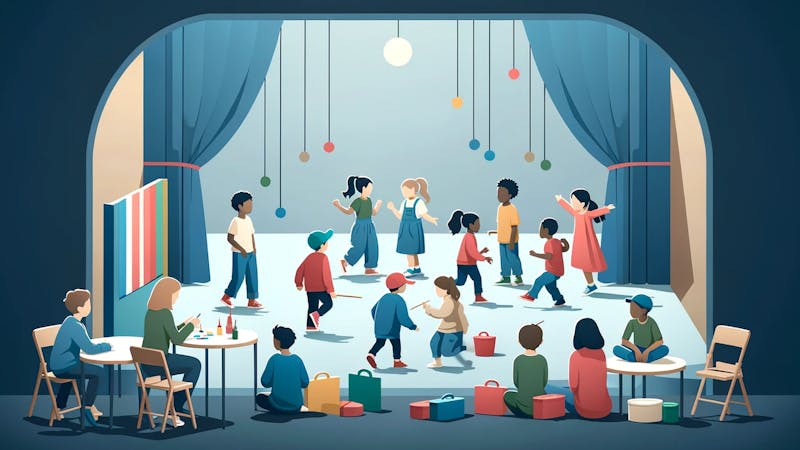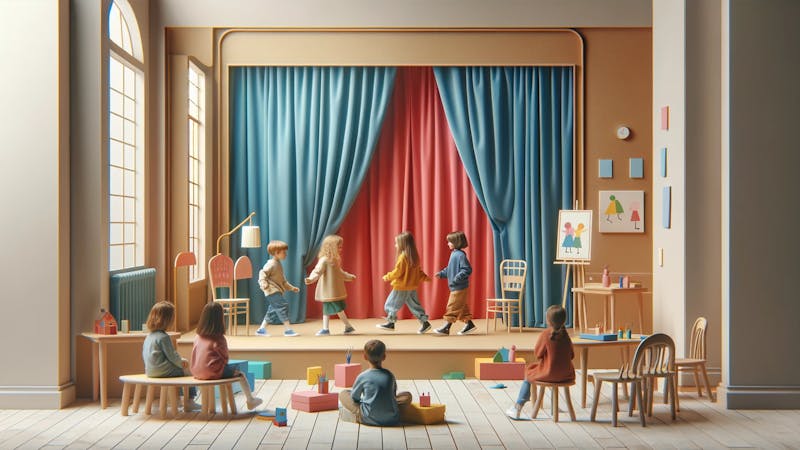The Best Drama Activities For Kids
Last update: 11/28/2025

Drama activities have much to offer and can be key in unlocking creativity and fostering emotional intelligence within children. Drama activities can cover everything, from improvisation and role-playing to concentration and focus. Let's turn our heads to the top drama activities you can use when educating kids. Discover how these engaging exercises not only entertain but also enrich young minds.
Our Favorite Drama Activities & Games
Let's start with our favorite drama activities, organized by different subgenres and purposes so that you can select the exercise that best suits your educational needs.
Warm Ups
10 Seconds
- Divide the students into groups of at least 3.
- Each group has 10 seconds to create different objects using their bodies.
- Encourage communication and teamwork within the groups.
- Instead of directing others, students should say, "I am going to be the [blank]" to indicate their role.
- Ensure that everyone speaks one at a time and listens to each other.
- Emphasize simplicity; the objects created don't need to be funny, just creative.
Alphabet Race
- Divide the students into groups of at least 3.
- The first student in each group points at another student and says, "A."
- The student then points at another student and says, "B."
- This continues, with students passing the alphabet around the group until they reach "Z."
- The first group to reach "Z" wins the round and celebrates by raising their hands over their heads and shouting, "Alphabet!"
- Emphasize that pointing should be random, with eye contact and focus to keep the game engaging.
Squirrel Game
- The whole class spreads out in the room (even possible with just a single student and teacher/leader)
- One student initiates by saying, "Look out, here comes a herd of squirrels," prompting the entire class to act as squirrels.
- Once everyone has become a squirrel, another student chooses a different animal or creature and says, "Look out, here comes a herd of [blank]," and the class transforms accordingly.
- Repeat the process with different students choosing new animals each time.
- Remind the class to fully commit to their role as any real or mythical animal.
Improvisation
Duck, Duck, Blank
- Students sit in a circle.
- Instead of saying "goose," the player who is "it" tags another player and assigns a category (e.g., cereal, fruit, sports).
- The tagged player stays in place and must quickly name three items in that category before the "it" player runs around the circle and returns.
- If the tagged player successfully names three items, the "it" player assigns a new category and repeats the process.
- Adjust the difficulty by increasing the number of items required to name.
Secret Suitcase
- The game's leader prepares a suitcase and a separate bag filled with random props.
- The leader secretly places props into the suitcase before each student or pair of students comes on stage.
- The students have two minutes to retrieve the suitcase and improvise a scene to the props found inside.
- Encourage creativity and spontaneity as students react to the unexpected items in the suitcase.
Freeze
- Form a circle with all participants.
- Two students step into the middle of the circle and begin a scene, using characters and situations provided by the leader if needed.
- At any time, anyone in the circle can yell "freeze," causing the two actors in the middle to stop and hold their positions.
- The person who says "freeze" enters the circle, taps out one of the frozen characters, and assumes their physical position.
- The scene then continues with the new actor, but the storyline changes to something different.
- This process repeats until everyone in the circle has had a turn participating in the scenes.
Character Building
Monologue
- This works best as a solo task.
- Ask students to write a 2-3 minute monologue in their character's voice. Students should be free to pick anyone as their character.
- Give students time to rehearse, emphasizing their character's speech and movement patterns. Consider how they would physically express their emotions and thoughts.
- Perform the monologue as if it were a scene from the play.
- Analyze what insights were gained by performing the character.
This Is Your Life
- Divide the group into roles - one person will be the biographer, another will portray the central character, and the rest will be significant people from the character's past (e.g., father, mother, first love, first boss).
- Allow the students to explore and make informed assumptions about their interactions and feelings towards the people in their lives.
- The biographer presents a chronological outline of the central character's life.
- Everyone improvises multiple scenes through the main character's life, allowing bigger and smaller storylines to be explored.
Day In The Life
- Split the group into individuals or small groups.
- Ask students to prepare a sequence of actions that depict moments when your character is alone on a typical day.
- Ask students to develop a story or imagine an emotion that affects that character's attitude and approach.
- Get students to rehearse to allow smaller personality traits to surface.
- Have students play out the events of a 'day in the life' of their character.
Physical Theater
Animal Exploration
- Assign different animals to each student participating in the activity.
- Provide time for students to research their assigned animals by studying videos or images. This helps them understand the physical characteristics and behaviors of their animals.
- Have students attempt to embody their assigned animals, focusing on mimicking unique physical traits and movements. Encourage them to explore how their animals walk, run, eat, and interact with their environment.
- After each performance, facilitate a group discussion where students can share their observations and feedback.
Speak With Silence
- Assign pairs or small groups and provide students with a basic scenario to act out.
- Explain to the students that the scene must be performed entirely in silence, using only physical expression to convey emotions, actions, and interactions.
- Each group performs their scene in silence for the class. After each performance, ask each group to interpret the performance they just watched.
Slow Things Down
- Assign pairs or small groups and instruct students to enact a short scene in slow motion.
- Provide students with a scene, or increase the difficulty and ask them to produce their own story.
- Ask the students to perform and explain their story, speaking specifically about the limitations of moving slowly.
Cross-Curriculum Drama Activities
Mantle Of The Expert
- Assign each student with a role with specialized knowledge or skills relevant to a specific dramatic situation or problem. Roles could include historians, social workers, CEOs, etc.
- Present your students with a task or problem related to the assigned roles.
- Students then act out their assigned roles, using their expertise to tackle the task. They may need to conduct research or background information to fulfill their role effectively.
- Ultimately, students should find a solution or explain with confidence in their role why a solution can't be found.
Task Time
- Divide students into small groups.
- Select a simple, everyday task or specialized task for increased difficulty, like making a sandwich or designing a city.
- Divide the task into parts equal to the number of people within the group.
- Each student exaggerates their part, creating a story for their assigned part of the task.
- Using this information, groups should create a scene and act out all the stories they've created.
One Word Story
- Arrange students in a circle, either sitting or standing.
- Decide who will begin the story and whether it will progress clockwise or counterclockwise around the circle.
- The first person in the designated direction starts the story by saying a single word, such as "There."
- Each subsequent person in the circle adds another single word to the story, building upon the previous word to create a coherent narrative.
- Encourage your students to keep to a theme or topic if no cohesion arises.
The 5 Best Online Drama Activities & Games Resources
Education doesn't just happen in the classroom, and we felt that including a list of our favorite online drama activity resources could benefit you and the children you educate greatly. Take a look and see which you could incorporate into a full and fun learning program.
Drama Resource
https://dramaresource.com/teaching-drama-online/
‘Drama Resource’ is an amazing online platform offering comprehensive guidance on teaching drama, catering to educators and students. As the digital landscape expands, the platform has recognized the need for accessible and engaging resources for virtual learning environments.
Beat By Beat
https://bbbpress.com/teaching-drama-online/
‘Beat By Beat’ offers concise advice for teaching drama online, addressing the unique challenges of virtual instruction. They have virtual monologues, family fairy tales, and even a digital talent show, all free to view and learn from. The site equips educators to engage students effectively in remote settings and succeeds in streamlining online teaching.
National Theatre
https://www.nationaltheatre.org.uk/learn-explore/schools/teacher-resources/
'The National Theatre,' an institution in the U.K., has a wonderful teacher resources hub on its site, and it's truly a treasure trove of educational materials designed to enrich drama instruction in schools. It has a wide range of resources, including lesson plans, workshop guides, and production insights.
Drama Online Library
https://www.dramaonlinelibrary.com/learning-resources
'Drama Online Library' has a fantastic learning resources section that offers a wealth of educational materials for drama enthusiasts. From study guides and scholarly articles to interactive quizzes and video tutorials, it provides comprehensive support for students and educators alike.
Drama Notebook
https://www.dramanotebook.com/teach-drama-online/
'Drama Notebook' offers an extensive guide on teaching drama online, providing educators with practical tips and creative lesson plans tailored for virtual learning. On their site, they've got it all, from interactive murder mysteries to social distance-specific activities, theater vocab, and tons more.
How to Find Drama Lessons & Classes
Now, we've looked at some of the best drama activities and resources you can use to educate, but the next question may be how and where you join a drama group or take drama lessons or classes.
Finding drama lessons and classes for kids is easier than ever, with an abundance of options available. Start by researching local community centers, theaters, and schools offering after-school programs. Connecting with people in person will aid communication and exponentially grow the skills you teach in the classroom or at home.
Online platforms also provide virtual classes taught by experienced instructors, allowing flexibility and accessibility. Consider the child’s interests and age group when selecting a class. Remember, the goal is to provide a supportive environment where children can thrive creatively and develop essential skills through the art of drama.
Conclusion
Drama is a subject that brings a lot of value and entertainment to many people's lives. Young or old, participating in drama activities can provide a fundamental understanding of personality, confidence, and communication. In children, drama can provide invaluable tools for holistic development, getting them closer to understanding their feelings and how they can interpret them. We hope this article helped you find the drama activities right for you and the children you educate. Remember what Alfred Hitchcock said; 'Drama is life with the dull bits cut out.'


